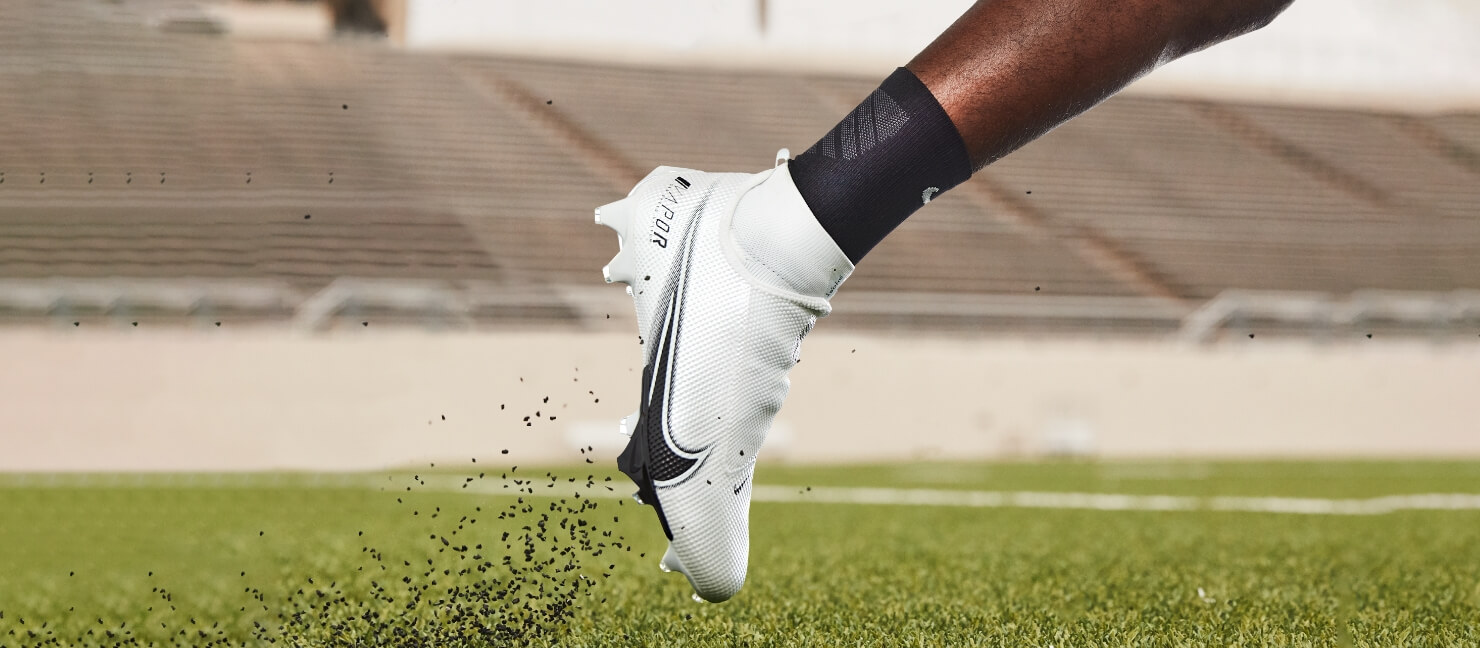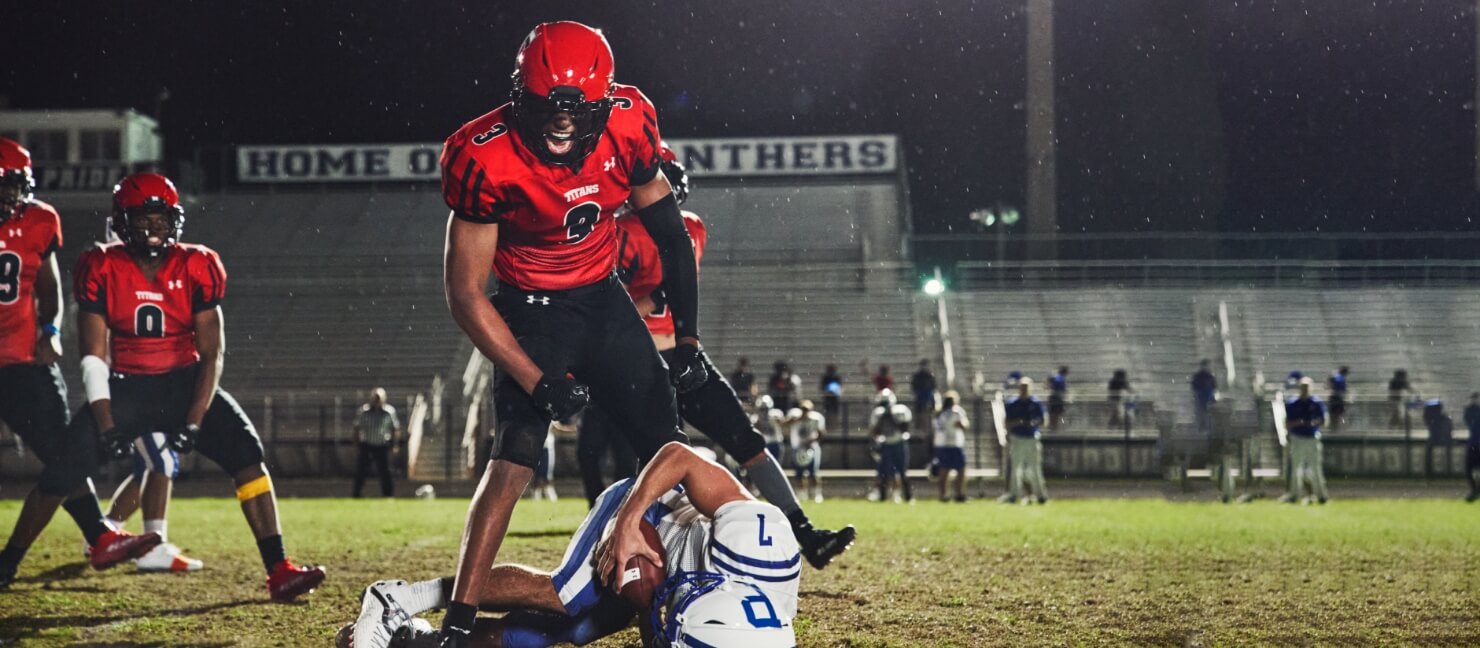Football Cleats Guide: How to Buy the Right Cleats for You

To make leaping interceptions, sharp lateral cuts, or sprint toward the end zone as the crowd thunderously roars, you need the right football gear that enhances your on-the-field talents. No matter which position you play, you’ll need the help of durable, high-quality football cleats for standout performances on the gridiron – especially since so much of football excellence derives from your footwork. But with so many available options, how can you be sure that you’re choosing the best cleats for your skills? Purchasing cleats are similar to buying the right shoulder pads, which is largely based on your position. The key to buying the right cleats is to determine the ideal shoe features and level of support for your position, skill level, and style of play.
Features to Consider for Football Shoes
With so many features to choose from, it can be challenging to find the best football cleats for your skill set. When shopping, keep in mind that you’ll want your cleats to provide:
- Reliable traction. Whether you’re trying to run a comeback route or kicking the extra point, it's important that your cleats give you traction with a combination of stopping precision and explosiveness on the field.
- Extra stability. When your shoes offer proper stability to help keep you upright, you'll find yourself being able to chew through defenses or change direction on a dime more easily.
- Strong support. Your cleats should offer you ankle support, added comfort, breathability and, above all, confidence.
To find out which cleats offer the traction, stability and support you need, try on a few pairs. While you shop, make sure you're looking for high-performance elements that match your playing position, including the cleat's cut and spike style.Still not sure which football cleats are best for yourself or your young student-athlete? Coach Townsend from Grind House Fitness shares his best tips to consider before buying.
Coach Townsend’s 3 Tips to Choose the Right Football Cleats
1. Consider the cleat spike type you will need.
- Rubber spikes have wider studs and deeper grooves for better traction, plus greater shock absorption.
- TPU spikes are made of plastic (TPU stands for thermoplastic polyurethane). They feel harder than rubber spikes but are more lightweight for greater speed and performance.
Check with your league officials or team coach to determine if you're required to wear certain spikes on the field. Youth leagues usually require using plastic spikes because they are more affordable, easy to use and help to increase safety on the field.
2. Football cleat cut length matters.
Does football cleat cut length matter? The short answer is: yes. Football cleats are designed in either low-cut, mid-cut, or high-cut designs. The choice you make depends on the level of support and mobility you want on the field. Your position also may impact the cut you choose.
Best cleats for power: High-top football cleats lace all the way up the ankle to provide the snuggest, most supportive fit, but the added bulk can make them heavier and impact mobility. This cleat cut length is best for players that operate near the line of scrimmage like linebackers, centers, and guards. This includes shoes like the Under Armour™ Men’s Highlight MC TX LE Football Cleats.
Best cleats for agility: Mid-cut football cleats offer a slightly looser, lower fit than high-cut cleats for easier maneuvering and moderate ankle support – preferred by players who need to move while staying protected in heavy traffic, like running backs, cornerbacks, and mobile quarterbacks. Shoes like this include:
- Under Armour™ Boys’ Spotlight Franchise 2.0 Jr Football Cleats
- adidas™ Men’s Freak 22 Team Football Cleats
- Nike™ Men’s Alpha Menace 3 Shark Football Cleats
Best cleats for speed: The lightweight design of low-cut football cleats offers better agility and navigation for running and breaking tackles – ideal for positions that need to cover the field quickly, like wide receivers, tight ends, and free safeties. This footwear includes shoes like:
- Under Armour™ Men’s Spotlight Lux MC 2.0 Football Cleats
- adidas™ Men’s adizero Football Cleats
- Nike™ Men's Vapor Edge Pro 360 Cleats
3. The most important factor for choosing football cleats is proper fit.
When trying on cleats, look for a snug fit across the front of your foot. Avoid a fit that’s too tight and feels like it restricts your toes’ mobility.
After you try on a pair and lace them up, walk around the store to see if you feel your heel slipping inside the shoe when running or walking. If you can feel your heel lifting from inside the shoe, then it is not the correct fit and could lead to losing your shoe during game play, or even worse – a potential injury. The right fit for the football cleats that are best for your position will help you dominate on the field.
Tips for Parents: How to Choose Kids’ Football Cleats
For little rookies in flag football or tackle, that first playing season is an exciting time. And you can start them off on the right foot by making sure they are outfitted with the proper gear. First, do your research. Knowing how the spikes work in terms of terrain and player position, as well as what’s allowed in your league, can help narrow down your choices. Next, weigh comfort and cost. Youth football cleats should fit properly, so your youth player can move well on the field. However, they’ll likely grow out of them by the time the season’s over, so try to find a pair that’s not too expensive.

Expert Tip:
Wear the same football socks to try on your cleats that you would on game day. This will give you the best idea about whether the cleats are a proper fit.
FREQUENTLY ASKED QUESTIONS
Q. Can you wear soccer cleats for football?
A. While there are many similarities with football cleats and they are generally allowed by an official, soccer cleats are not recommended for best performance results or safety during football practices or games.
Certain soccer cleats are designed for harder playing surfaces such as dirt or turf, so they utilize shorter spikes. However, when you’re playing football on a field with longer grass or muddy conditions, longer spikes are recommended for digging into the ground and providing ample traction.
Q. How much are football cleats?
A. Football cleats range in price and may be marked anywhere from $25 to $200. The cost depends on several factors, including the type of cleat (youth or adult), materials, and brand. Additionally, proprietary footwear technology that supports player performance also often plays a role in the shoe’s price point.
Q. Does playing surface matter when choosing football cleats?
A. Yes. While some football cleat types work well on most surfaces, others are better suited to specific terrain. For example, shorter studs work well on firm, dry ground, while longer studs dig deeper into wet fields, creating more traction for the player. To accommodate different conditions, some players buy football shoes with detachable cleats that can be swapped out as needed.
Q. Do cleats feel the same as sneakers?
A. No. This is an especially important note for younger players who are trying these shoes on for the first time. Football cleats have a different feel and finding the right pair is important for player performance. Sneakers are more flexible right out of the box, while cleats may feel heavier and stiffer — similar to a pair of dress shoes. They’ll break in eventually, but it’s important to know that they won’t feel the same as the sneakers he usually wears to gym class.
Q. Are my cleats supposed to fit tight?
A. When it comes to the shoes you’re wearing during games and practices, comfort is key. Your cleats should be snug enough to make quick movements. Cleats that are too loose may increase the player’s risk of injury, but cleats that are too tight may cause pain, irritation, and discomfort. Make sure you try on a few pairs from different brands to find out what works best for you or your young athlete.